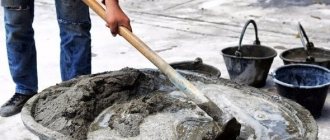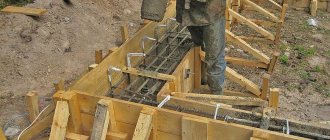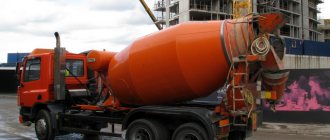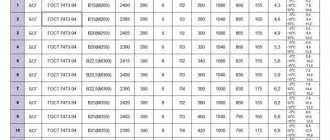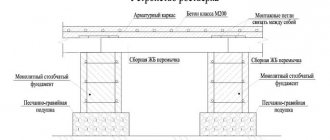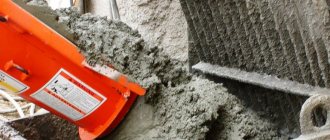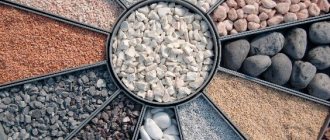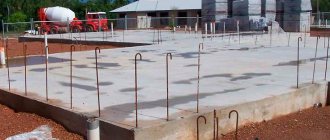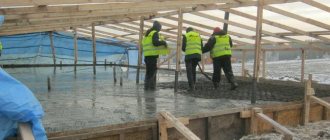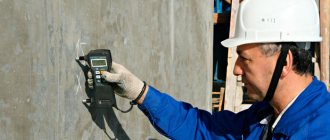Marking and its meaning
For ease of use and to differentiate compositions according to technical characteristics, product packages are marked in production. Consumers can easily determine what kind of cement is needed for the foundation of a house, guided by the markings on the package and the technical features of their structure.
Marking allows you to select the appropriate composition for suburban low-rise or urban high-rise construction. Among the most common alphabetic and numerical abbreviations, the following should be highlighted:
- "D 0". Indicates products without additives.
- "N". Denotes cement standardized by the amount of clinker.
- "B". Marks a fast-curing product.
- "PC". Portland cement.
- "BC". Focuses consumer attention on white raw materials for finishing work.
- "PL". Plasticized products with high frost resistance.
- "GF". Marks hydrophobic raw materials that cannot absorb liquid during the first five minutes. Additional features of this product are plasticity and increased frost resistance.
- "SS". Classifies sulfate-resistant cement. It is used for special construction in aggressive environments.
- "VRC". The marking highlights a special raw material that sets quickly and expands as it hardens. The product is waterproof.
"D 20". Characterizes a mixture containing 20% cement and 80% additives.
If you buy powder in bags, you may also see other markings.
If the package indicates the designation “PTs400 D20” or “M400”, then the foundation can be poured using this composition for private small structures. Another factor influencing the choice may be the ratio of price and quality of products. For use in conditions of high humidity or low temperatures, it is recommended to purchase products marked “PTs400-D0”. When constructing foundations for buildings with several floors or hypermarkets, the composition “M500” or “PTs500 D20” is used. For areas with unstable climatic conditions, it is recommended to purchase the “PTs500 D0” grade of cement.
To know which cement is best to purchase for the foundation of a house, you need to determine the type of soil. The latter is often of no small importance when pouring the foundation. Experts recommend using concrete grades “M250” or “M200” on rocky and sandy soils. For clayey soils, purchase material with the designation “M300”.
Brand selection
For the construction of a residential building, cement grades M400 and M500 are recommended. In this case, to fill the foundation, about 480 kg of cement is taken per cubic meter of solution. M500 is used in the construction of multi-story structures and large buildings.
It is worth considering that damage to the packaging will cause the material to absorb moisture and become unusable within a few days. It is important to know how to calculate the cement for the foundation correctly in order to accurately calculate how many packages are needed and not buy material in reserve.
In addition to marking the cement, additional indices :
- D0 indicates that the cement is without additives.
- D20 means that the composition contains 20% additives.
Different abbreviations are also used. PC stands for Portland cement, Pl stands for frost-resistant and plasticized. If the soil is dry, then Portland cement is used.
The following recommendations will help you choose the right brand of cement for building a foundation:
- Cement PC400 D20 and M400 are used in the construction of small objects and to create foundations for private buildings. At the same time, price and quality are in an optimal ratio.
- If high water resistance and frost resistance are required, then PC 400 D0 is used.
- For industrial buildings (hypermarkets, multi-storey buildings and hangars) cement M500 or PC500 D20 is used.
- PC500 DO is recommended for industrial buildings in areas with humidity above the permissible norm and in regions with an unstable climate.
The quality of the prepared concrete is influenced by the type of soil where construction work will be carried out. For rocky and sandy soils, concrete M250 or M200 can be used. It is worth considering that the grade of cement for the foundation M400 is used to create M200 concrete. In this case, the ratio of cement, crushed stone and sand is 1 to 4.8 and to 2.8. For M250 this ratio is 1:3.9:2.1.
When building a foundation on clay soils, M300 concrete is used, which has more durable properties. It is obtained from M500 cement, and the ratio of the starting material, crushed stone and sand is 1 to 3.7 and to 1.9.
Before preparing the solution, you need to check the quality of the sand. The sand is poured into a tank of water and left for a day. If during this time the water has become cloudy, then the material cannot be used to prepare the foundation. You also need to check the quality of the cement. There shouldn't be any fossils in it. This material begins to harden in the corners of the package. Therefore, first all corners are checked for softness.
The best option for building a foundation is Portland cement without additives. Pozzolanic and slag type of material can also be used.
The foundation is the foundation for every building. The durability and reliability of the structure depends on its quality. Therefore, the choice of cement must be taken responsibly. Knowing the brands and their characteristics will help you avoid mistakes when purchasing.
Types of additives
For strength and durability of the base, as well as to improve performance characteristics, various substances are used in the preparation of the working solution. All additives available today can be divided into several categories:
- Plasticizers. They allow you to use less liquid during the preparation of the solution. Such a foundation will freeze less in winter and will not sag after several years of operation of the building.
- Antifreeze additives. They are used to work at sub-zero temperatures, preventing the composition from hardening in the cold.
- Seals. They are used to increase the strength of raw materials when constructing walls of small thickness.
- Strength gain accelerators. They are used in the construction of structures in a short time. In this case, the cement quickly gains the necessary strength after pouring.
- Retarders. They are used when transporting raw materials over long distances. They allow you to keep the cement in a liquid state.
In some cases, universal additives are used. They combine several properties at once and allow you to obtain material of the required quality.
Tips for a beginner master
If you decide to refuse the help of professional workers and do all the work yourself, then you should take into account some recommendations. Guided by the advice of experienced people, you can pour the foundation for any building with your own hands.
When purchasing raw materials, you should take into account that the quality of the product is proportional to its sales period. For foundation construction, high-quality compounds are usually used, which lose their beneficial qualities very quickly. For this reason, it is recommended to purchase only material of a light gray or greenish tint.
The composition should be different in flowability. This quality can be checked by taking a small amount of material into your palm. It would also be a good idea to check the certificate with the seller. When carrying out large volumes of work, it is better to purchase goods in plastic containers, which are opened immediately before starting work and used completely.
To enhance the strength of the base, special substances are added at the time of preparing the working solution: plasticizers, fiber. When pouring a strip foundation, additional reinforcement, gravel or hard crushed stone with a fraction size of 20 millimeters, as well as related materials for waterproofing, are purchased.
Which cement is best to choose for building a foundation?
And before you decide whether to make a solution or order a ready-made one, you need to take into account the specifics of the work: the main argument in favor of a ready-made solution is the thoughtful marketing of the manufacturers. Experienced developers made simple calculations and found out that the required brand of ready-made concrete for pouring a foundation is not much more expensive than cement mortar, which you will have to make yourself. At the same time, in order to correctly fill the future foundation with ready-made concrete, it is necessary to organize access to any point in the trench or make trays of the required size.
When preparing the composition yourself, it is difficult to follow such a technology, but you can order m3 in a mixer, attract helpers and fill the entire trench in a few hours. Making a solution or ready-made concrete Those who prefer ready-made concrete must remember that the composition of the mixture has time to harden during transportation.
Composition of classic concrete: sand; cement M for producing concrete M Technology for pouring a foundation for a garage Theoretically, pouring a strip foundation involves filling a prepared trench with concrete after installing the formwork and reinforcement.
However, in practice, the methods of pouring the foundation may differ: Pouring the foundation in parts with a technological break of up to three hours. Crushed granite gravel provides the best traction.
As for sand, in theory it is recommended to use sea sand, but regular sand from a sand quarry will do. It is important to note that the sand should be pre-strained to remove clay and other unwanted inclusions. There are no special requirements for water; ordinary tap water will do. The cement-water ratio is The preferred method is to use a concrete mixer, but manual mechanical mixing of the solution is also possible.
The process of mixing the working composition
To obtain a durable connection, it is not enough to buy high-quality raw materials. It is important to prepare the working solution in the correct ratio of substances. To obtain a good mixture, you must follow the manufacturing technology:
- 4/5 of water is poured into the concrete mixer.
- Add gravel or crushed stone.
- Sand and cement are poured.
The remaining fifth of the water is added in small parts while mixing.
Special additives are added during the preparation of the mixture as needed. When compiling a rating of Russian companies engaged in the production of concrete, the Borshchevsky and Novgorod plants should be highlighted. Mikhailov Cement Rusean also produces a high-quality product at reasonable prices.
The basis of any building is the foundation. The durability of the entire structure will depend on its quality. For this reason, the choice of cement should be approached with the utmost care. Knowing the brands and characteristics of products will help you avoid mistakes in the process of purchasing raw materials.
If you do not have the necessary construction skills and knowledge, it is recommended to turn to specialists. They will help you choose cement depending on the type of structure being built. For the foundation of a prefabricated panel house, raw materials of the “M200” brand are used, and for the foundation of a log house, “M250” and “M300” are used. It is recommended to erect brick buildings and objects on clay soils on a foundation poured from M350 or M400 cement.
Construction secrets: how to properly pour a foundation for a garage
Author: Redaktor · Published · Updated
Pouring a foundation for a garage is an important stage, since the stability of the entire structure and its protection from moisture and cracking will depend on the strength of the foundation.
We looked at how to pour a foundation for a garage, what kind of concrete is needed, what types of foundation require pouring, and in which cases you can do without it.
Types of bases
In total, four types of foundations can be distinguished: monolithic, strip, pile and slab. Monolithic and strip systems cannot do without such an important stage as pouring the foundation for the garage. The monolithic system is a pedestal that follows the perimeter of the building. It consists of a reinforcing layer of crushed stone and clay, wooden formwork, a reinforcing frame and a concrete screed.
The strip base is built along the contour of the building and also includes a cushion of sand and crushed stone, formwork, a frame made of reinforcement and a base made of mortar.
When constructing a tiled structure, no mortar is needed. The system is a cushion of crushed stone and sand on which a reinforced concrete slab is installed.
This is a faster method since you don't have to work with the solution and wait for it to dry. But for construction you will need special equipment, since it is impossible to work with a reinforced concrete slab manually.
A pile system can consist of two types of elements: ready-made rods, which are driven into the ground using vibrating machines, or casting rods, which are formed from concrete in pre-prepared wells.
As a result, we can say that working with mortar will be necessary in the case of a monolithic, strip and sometimes pile foundation.
The cost of building the foundation is approximately 1/5 of the total construction budget. You should not save at this stage, since the reliability of the entire structure depends on it.
What grade of concrete is needed for a garage?
There are a huge variety of concrete types. They all differ in brand and compression class. And depending on this, they can be used for external or internal work, or in a specific area.
The most popular brand is M200. Let us consider the properties of such concrete in more detail.
This material is widely used for the construction of civil and industrial buildings for screeding floors, forming the foundations of buildings, stairs, walls, and sidewalks for pedestrians.
The material is manufactured in accordance with GOST requirements.
Its strength may well be sufficient for the construction of a high-rise building, but according to the standards, this material is used in the construction of small country houses, cottages and parking lots.
Among the advantages of the brand, it is worth highlighting its high compressive strength, frost resistance and reasonable price.
We’ll also talk about how preferable it is to buying a ready-made mixture instead of mixing it yourself. Not everyone can make a solution that is correct in all respects. Therefore, it is important in this matter to consider a number of features of purchasing ready-mixed concrete:
- the cost of the finished mixture and the price of its individual parts for mixing yourself are almost equal. Thus, you will receive cement of the quality of which you will be confident without overpayments;
- To form a homogeneous and uniform base, it is necessary to fill in one stage. It is quite difficult to prepare the required amount of mortar and load it into the formwork manually. When you order ready-made material, they will bring you at least 6-8 m3 and you can quickly backfill with 2-3 assistants;
- To ensure unloading of material, it is necessary to organize the access of a concrete mixer to the site. In addition, the standard length of the feed chute is 1.5-2 meters. You will have to compensate for the missing length with available materials. To do this, a gutter is formed from boards in the shape of a tray;
- During long-term transportation, the finished cement may thicken. Therefore, when accepting it from the supplier, you should carefully check the consistency.
For those who still decided to do everything manually and independently, here is a standard recipe for preparing the mixture.
You will need:
- sand;
- cement M400 (when diluted in proportions, the grade M200 will be obtained);
- water (per 1 m3 of concrete 0.68 m3 of water);
- crushed stone
When mixing, observe the following proportions: 1 part cement / 3 parts sand / 5 parts crushed stone.
How to pour a foundation for a garage: preparatory work
To begin, you prepare the area. Clear it of trees, bushes, debris and grass. If necessary, it must be leveled. Next, carry out the markings according to the previously drawn up drawing. To do this, use pegs on which you can stretch nylon twine. Next, a trench is dug. A layer of clay 10 cm thick is laid on its bottom. A cushion of sand and crushed stone 10-15 cm thick is formed on top. Everything is covered with geotextiles. Next, the formwork and reinforcement frame are installed. It is better to use removable formwork, which is a box. It can be removed after the mixture has hardened.
Next, pouring is done in parts. To do this, using a fishing line, the level of the first layer is determined and the laying is carried out. To prevent the formation of bubbles, it is necessary to use a vibropress or simply tap the entire perimeter of the formwork evenly. Next, the layer is covered with roofing felt or plastic film and after 2-3 hours the next level is formed. This technology is called “Hot seam”, when the next layer is laid before the previous one hardens.
The “Cold Seam” technology involves the formation of the next layer after the previous one has hardened. This approach is optimal for those for whom construction deadlines are not critical.
But still, it is worth noting that the best option is monolithic pouring, when the entire volume of the mixture is unloaded into the formwork. This method is good because you will get a homogeneous structure, while when working in layers, non-uniform hardening is possible. And this can lead to cracking of the entire structure.
An important nuance when forming a tape base. When filling the entire volume of the mixture, be careful not to concentrate it on one area of the formwork. Otherwise, the liquid part of the mixture may spread to distant corners of the mold, while the rocky part may remain in the place where it was poured, and then you will not be able to distribute it over the entire area.
Taking into account all the nuances, you form the entire thickness of the base, level its surface with a trowel and after 2-3 hours cover it with burlap.
If construction is carried out in the summer, the structure must be moistened every 2-3 hours to prevent cracking. If work is carried out in winter, autumn or rainy weather, cover the structure with plastic film.
It is important to consider how long the mixture takes to dry. If you continue to work until the structure is completely dry, it will become covered with cracks and eventually collapse. The optimal period for complete drying is considered to be 4-6 weeks.
Now you know how to fill the base with your own hands and what to consider to make it strong and durable.
Useful video
nashadacha.online
What brand of cement is best to use for pouring the foundation?
After cement material was invented, there was a dramatic revolution in construction technology. Cement began to be considered the basis for the construction of various structures and monolithic elements. It is used to bind solid filler components into a homogeneous concrete mass. As a rule, concrete is used for the construction of foundation structures, preparing a mixture in a certain proportion of sand, crushed stone, water and cement. You need to understand exactly which cement is best for the foundation in order to get a reliable and durable monolith.
Dependence of concrete grade on cement grade
When building foundations of various types, cement is used to make a special building mixture called concrete. In addition to the described binder, it contains various fillers, among the most common of which are the following:
Cement dependencies
- Sand;
- Crushed stone;
- Sawdust;
- Slag;
- Expanded clay.
Each filler gives the final mixture certain additional properties and qualities. Classic concrete consists of cement, crushed stone and sand mixed with the addition of water. The quality of the mixture is mainly influenced by the binder.
Concrete is classified according to the load it can withstand. To determine it, laboratory tests are carried out on samples and the mixture is marked according to them, depending on the composition and one or another type of binder. For certain types of buildings, it is advisable to use different compositions depending on the required strength characteristics.
It is impossible to answer unequivocally which cement is better for the foundation. The quality of the binder is influenced by a large number of different factors. It should be remembered that the indicated tabular characteristics of concrete correspond to freshly prepared cement of a particular brand. After a certain storage time, the quality of the powder decreases sharply. This must be taken into account when choosing the ratio of mixture components.
Among the most common grades of concrete are mixtures marked M400 and M500. The traditional ratio of the components of mixtures of cement, sand and crushed stone is distributed in the ratio 1:3:5. Moreover, the quality and brand of the binder has a direct impact on its quantity. Thus, cement of a higher class can be added to the mixture in smaller quantities, and of a lower class - in larger quantities.
How does the brand of mortar depend on the brand of cement material?
Fillers used for concrete give the solution certain properties and additional qualities.
In the classic version, concrete is composed of crushed stone, cement and sand, when mixing which a certain amount of water is added. The quality of the mixture being prepared depends on the binding component.
Concrete solutions are differentiated by the load forces they can withstand. To determine it, laboratory tests of samples are necessary, according to which the mixture is labeled according to the composition and type of binder. For different types of buildings, certain concrete compositions are used, taking into account the required level of strength.
There is no definite answer as to what brand of cement is needed to fill the foundation. The fact is that the quality of the binder is determined by numerous factors.
Most often, builders use M400 or M500 cement. As a rule, cement, sand and crushed stone are taken in a ratio of 1 to 3 to 5. The quality characteristics and brand of cement directly affect the quantity. For example, a higher class is added to the mixture being prepared in a smaller volume.
Brand of concrete for pouring the foundation
In fact, there are only two criteria for choosing a brand of cement for pouring a foundation:
- The brand of cement will depend on the brand of concrete that will be used to build the foundation. The grade of concrete, in turn, depends on the mass of the structure and the characteristics of the soil;
- Which brand of cement can be purchased in your area.
Let's look at these two factors in more detail. In accordance with building regulations and practical experience, the following recommendations can be given on the grade of concrete for the foundation, on which in turn (and not vice versa) the factor under consideration depends - what grade of cement is needed for the foundation :
- Concrete M150 is suitable for pouring light-loaded foundations of courtyard buildings, light garages, fences and small wooden and foam concrete houses;
- Concrete M200, being the most common grade in low-rise construction, can be used for the construction of foundations for small residential buildings with light floors;
- Concrete M250, M300 or 350 is capable of withstanding significant loads from “heavy” private houses with a height of more than one floor, up to five-story cottages;
- Concrete grades M400, M450, M500 and higher are rarely used in private housing construction, due to the significant unreasonable increase in construction costs. As a rule, these grades of concrete are used for pouring foundations for multi-story buildings, overpasses, bridge crossings and other heavily loaded structures.
- Depending on the nature of the soil, it is recommended to use the following grades of concrete. In case of rocky or dry sandy soil, concrete M200 or M250 will be sufficient to fill the foundation for any low-rise building; for the more common “heaving” loam or clay in Russia with close standing groundwater, concrete should be used at least M250, preferably M300 or M350.
How is cement marked?
Not only the operational life of the structure, but also its tensile and bending strength indicators - those types of loads that the concrete strip experiences most of all - depend on the cement used to fill the foundation base. To know what brand of cement is needed for the foundation of a house, it is recommended to understand its differences.
NOT so long ago, a concrete mixture was prepared on the basis of one of the binding components - PC (Portland cement) or ShPC (slag Portland cement). The main difference was the powder composition and strength characteristics. The grades of cement for the foundation complied with current GOST standards.
In addition to the name, the brand of cement material for constructing foundations and other works contains a designation with numbers that indicate the maximum strength under load until complete destruction.
Now let's see what grades of cement there are, how the marking is applied and what its meaning is.
According to the old designation system, several brands were distinguished:
- M 300 - withstands loads of up to three hundred kilograms per square centimeter of surface;
- M 400 – corresponds to a pressure of 400 kg;
- M 500 - withstands impacts of at least five hundred kilograms per unit of area;
- M 600 - carries a load of six hundred kilograms.
The characteristics given here are not able to give unambiguous advice on what brand of cement to use for constructing the foundation of a house, and what to use when building lighter structures. Naturally, for large structures it is necessary to take material with a greater load. But you can prepare a concrete solution with the required characteristics by changing the amount of cement composition of a lower grade, increasing its quantity.
When determining which cement material is best for the foundation of a house, it is recommended to pay attention to the presence of mineral additives in it and their quantity.
This criterion is present in the labeling of the material, and its presence is indicated by the corresponding letters and numbers D0 or D20. Before making the final choice in cement, it is recommended to clarify how mineral components influence the quality of the binder. For example, D0 does not contain any components, and the solution is of the highest quality. But the brand with the designation D20 contains up to twenty percent of impurities, which reduce not only strength, but also cost. When choosing a cement material, for example, to construct a fence foundation, you can use a powder with a lower strength index, thereby reducing the overall cost of construction work.
When deciding which material is best to use for pouring a strip foundation, you should study the remaining characteristics of the component indicated in the labeling. The most common designations are:
- PL – cement contains plasticizer additives. This type of foundation material is used when the region experiences low temperatures in winter;
- VRC - this abbreviation denotes the moisture resistance of the mixture and the increase in volume during hardening. If you are in doubt which cement is best for a foundation in a swampy area, then you will not find another option;
- B - such material requires less time before final hardening. If you have a choice about what to use for the foundation of a house, when the time frame for work is limited, choose this particular cement material;
- SS – sulfate-resistant cement. It is rarely used by private developers, because its main purpose is considered to be concreting hydraulic structures. When plugging oil and gas wells, plugging cement is used - a mixture of clinker powder, gypsum and other components;
- N – cement with this marking has undergone additional rationing using clinker. This additive ensures high strength of the material;
- BC – “white cement”. A distinctive feature is that it becomes lighter after hardening. It is rarely used, mainly for finishing work.
Assessment of the quality of cement raw materials
A low-quality material will not make a good concrete foundation, and you should learn to identify its signs by appearance.
When choosing which cement is best for the foundation of a house, garage or for the foundation of a bathhouse, you should pay attention to a number of indicators:
- date of production - the quality characteristics of cement gradually decrease during storage of the material. If the cement was made six months ago, then it is not recommended to use it for serious objects;
- consistency - ideal powder state - loose, without lumps. This is easy to check - the packaging is touched and turned over;
- packaging material must remain intact and dry. When deciding which cement is better, check the name of the manufacturer and production time. If there is no such information, there is no point in buying the material.
Other properties
Let's also consider other characteristics that each type of cement should have. Thanks to this quality, it is possible to determine the service life of structures made of concrete. This is explained by the fact that such a characteristic helps to resist the negative impact of the external environment. Corrosion resistance indicators, in turn, depend on whether there are cracks, pores and capillaries in the concrete structure. Through them, excess moisture, which often includes various types of acids and alkalis, enters the structure.
Foundation hardening
As for air resistance, this characteristic represents the ability to preserve the beneficial properties of a concrete structure in the open air. The indicator under consideration depends on the conditions of storage and transportation of the building material. If you use cement to fill the foundation, you should take into account the possibility of deterioration of properties during storage. Among other things, also pay attention to the recommendations for the use and storage of this or that cement; information about this is usually provided by the manufacturer.
Shrinkage and swelling, which determine the ability of cement to change its volume, are of no small importance. During the swelling process, concrete grows in mass, and this is done due to the absorption of excess moisture from the external environment. It should be noted that this process does not lead to a deterioration in the strength characteristics of concrete. As for shrinkage processes, they appear when the cement stone hardens in dry air. This phenomenon also occurs in cases where the correct ratio of cement and sand in the solution has been chosen.
Another characteristic of each concrete, which is highly recommended to pay attention to, is the fineness of grinding of this material. It is associated with the setting speed of concrete, as well as with the set of its strength properties. It is also worth noting that the better the material is crushed, the better its characteristics will be.
What to use when building a foundation
We have to remember that the soil composition may differ in certain characteristics. For dry soil, it is better to prepare a solution from cement grade 500 D0, and you will get a mixture of grade M 350.
You can use the help of experienced builders who will tell you which brand of cement is best to use in a particular case, in what proportions to mix, and what sand dispersion to choose.
As a rule, M 400 and PC 400 with a D20 indicator are used in private construction for the construction of a one-story house and utility room. For such foundations, the maximum load is not the main indicator, and cement of this brand is considered an ideal solution that saves money.
M 400 and PC 400 D0 are almost similar in properties to D20, but do not contain impurities. And if you are building a foundation that must be used in a humid environment and in severe frosts, and do not know which cement is better - with or without additives, use “clean” material.
M 500 and PC 500 D20 are good cement for foundations for large industrial and administrative facilities, high-rise residential buildings. For construction in frosty and humid regions, it is better to use PC 500 D0.
Concrete marking
M300 concrete is excellent for a private home.
The grade of concrete depends on the strength characteristics of the cement. To fill the foundation of a private house, concrete grade M 300 is mainly used. Such concrete can withstand a load of 400 to 500 kg per 1 sq. m. cm. This is enough to build the foundation of a two-story private house.
There are a wide variety of types of cement with various additives. These can be substances that improve certain qualities of the material. As a rule, additives are used when performing special work. To prepare the concrete foundation pour, Portland cement is used without any additives.
We evaluate the composition of cement raw materials
To check the composition and practical quality of cement, mineral water containing bicarbonate, without gases, is used. Cement powder is mixed with this water until it forms a dough. A flatbread is prepared, thick in the center and thin at the edges. If high-quality material that does not contain additives was used to make cement, the cake hardens in ten to fifteen minutes, and it is quite difficult to destroy it (especially in the center).
At the moment of hardening, the cake heats up and changes color from gray to bluish-green. This effect does not occur with every cement material and depends on the specific manufacturer.
If the cake remains soft for half an hour, the cement does not have good binding qualities; it contains impurities, about which you will not find any information on the packaging material. As follows from the reviews of developers, such material is not suitable for foundations, because it cracks during the hardening process.
Types of main brands of cement
The main grades of cement used in the manufacture of foundations:
- Portland cement PC - old standard, TsEM I - new;
- slag Portland cement, respectively ShPTs and TsEM II - slag After the name code in the marking there are numbers indicating the strength of the binder according to the outdated standard in kg/cm²: 300, 400, 500, 600. The current standard provides for the expression of the compressive load in MPa - 22.5 ; 32.5; 42.5; 52.5. Examples of designations: PC-500, ShPTs-300, TsEM I-42.5; CEM II-22.5. To simplify the recording, instead of the combination PC, the letter M is used - Portland cements M400, M500.
The presence of active additives in cement is indicated by code D: if their content is Selecting a brand for pouring the foundation
The concrete mixture, like cement, is marked depending on the compressive strength of the hardened sample. The indicator is designated by the symbol M, and the numbers are given in kg/cm².
At the same time, the brand of binder and the monolith based on it do not always coincide: M200, 300, 400, 500 concretes are made using M400, M500 cements. Each foundation is calculated based on load; the grade of mixture for pouring individual blocks is indicated in the design documentation. Recommended concretes:
- M100 - pouring the foundations of private houses, garages and country houses;
- M200 is used for the construction of two-story cottages, if the frame is on 3 levels, use M250;
- M300 - for the foundations of massive structures consisting of several horizons;
- M400 - for the foundations of multi-storey buildings.
The choice of cement begins with an inspection of the packaging; the brand and expiration date must be indicated on it. The binder can be stored for 2 months. If the product is older, it loses 10-12% of its activity. If the manufacturer's stamp is worn out or is not found on the bag, you need to check the accompanying documents for the batch of cement to ensure freshness. You can touch the bag: good cement is pressed, unlike hardened, expired powder.
Choosing concrete for the foundation
The grade of concrete is a very important characteristic, the correct choice of which determines the integrity and durability of the erected structure. To determine the grade of concrete, you need to know what material the walls and roof will be built from, the quantity of these materials and their total weight.
You should also know the snow load for a particular region. This data is required for mathematical calculation of the load on the foundation surface in kg/cm2. Depending on the obtained load value, one or another grade of concrete is accepted: M200, M250, M300 or M400.
At the same time, the answer to the question of what kind of cement is needed for the foundation is found in the recipe for preparing a particular brand of concrete. As already mentioned, these are binders: CEM I 32.5N PC or CEM I 42.5N PC.
Let's consider an example of calculating the load on “our” foundation with dimensions of 26x0.5x1.0 meters. We set the following initial data for the calculation:
- The wall material is foam concrete, the height of the walls is 3 meters, the area of the walls is 78 m2, the volume of the walls is 31.2 m3, the approximate weight of the walls is 18,720 kg.
- Roofing material – slate, roof area 50 m2, approximate roof weight 2,500 kg.
- Snow load for the Moscow region is 126 kg/m2. Accordingly, the snow load on the entire roof: 126x50 = 6,300 kg.
- Area of the foundations that can bear the load from the walls and roof in centimeters: 2600x50=130,000 cm2.
We take the total load on the foundation as the sum of the weight of the walls, roof and snow cover multiplied by a factor of 1.3, which takes into account the approximate weight of home furnishings, frames, doors, people, etc.: 18,720+2,500+6,300x1.3=27594 kg .
The load per unit surface of the foundation is the value of the total load divided by the surface area of the foundation: 27,594/130,000 = 0.21 kg/cm2.
Concrete capable of withstanding such a small load can be any of the above. Therefore, guided by economic considerations, we accept the M200 brand, which theoretically can withstand a compression load of up to 150 kg/cm2.
Amount of cement per foundation
Manufacturers of concrete structures purchase M500 cementitious powders packaged in soft, single-ton containers, or organize wholesale delivery using cement trucks. Small consumers and private developers purchase cement in paper bags - this is the M400 brand. To understand how much is required to build the foundation of a house, you will need to perform a calculation. The following scheme is used for calculations:
- the brand of cement is selected;
- the volume of the foundation and the required strength are determined: the formwork cavities filled with concrete mixture are measured;
- from the reference table, the required value of the specific consumption of cement of a given grade is selected to obtain a monolith of the established strength;
- the necessary need is determined by multiplying the volume of concrete work and the rate of cement use.
Foundation cement
As for gravel, it is necessary to take into account that its choice depends solely on the type of construction. If you plan to build a one- or two-story building, then the diameter of the gravel should be about 0. In the case of a reinforced foundation, it is necessary to use smaller gravel - approximately 0.3 cm. Cementation of the foundation is a very important stage in construction. At this stage, it is recommended to provide drainage, determine the parameters of the structure, including the weight of the building, and the method of pouring.
Selecting a concrete grade based on strength characteristics
A distinctive feature of this type is the complex technology of pouring a monolithic foundation and its high cost. In addition, when choosing a tape, experts recommend involving assistants and preparing for the long process of creating a solid foundation.
However, this type of foundation has an undeniable advantage - it evenly distributes the load and firmly connects the main building to the ground. Making mortar or ready-mixed concrete The classic cost-saving option - studying the composition of concrete for pouring the foundation and making it yourself - is not suitable for everyone.
Component proportions
Concrete mortar for large construction projects is made in factories, but for small enterprises and private owners, the best way to pour the foundation is to independently produce a cement mixture: sand, crushed stone and water with cement.
The components must meet the requirements: sand must not contain clay particles, its fraction is from 1 to 2.8 mm; crushed stone with a particle size of 1-2 cm, and only clean water, without any impurities.
Mixing proportions depend on the required strength of concrete and grade of cement. Weight ratios C:P:SH:W for binder M400:
- 1:4.5:7:0.5 for monolith M100;
- 1:2.8:4.8:0.5 is used for grade M200;
- 1:1.9:3.7:0.5 to get strength M300;
- 1:1.2:2.7:05 for M400 concrete.
The proportion for preparing the M200 mixture should be 1: 2.8: 4.8: 0.5. This means that to mix 1 m³ of concrete you will need: M400 cement - 263 kg, river sand - 738 kg, crushed stone or gravel - 1265 kg, water - 131 liters.
Mixing concrete
Small volumes of concrete mixture are prepared by hand using an old trough or bathtub. First, add cement and sand, mix until smooth, add water and repeat the procedure. Lastly, crushed stone is added.
By using a concrete mixer, the speed of concrete production increases. Mechanized mixing involves performing operations in a prescribed sequence. After starting the drum, the components are gradually added:
- cement and a small amount of water - until uniform mixing is achieved;
- sand is poured in small portions;
- Little by little crushed stone is added to the almost finished mixture, and water is added if necessary.
The cement mixture sets in 10-12 hours, and hardens in a week. Full strength is gained a month after pouring at a temperature of 20ºC.
Additives to concrete
In addition to the strength of the foundation itself, the concrete mixture must provide other important characteristics: plasticity, water absorption, frost resistance. If the mortar is used as a masonry mortar, the workability and survivability of the mixture must be ensured. The beneficial qualities of the concrete mass are controlled at the mixing stage through the use of chemical additives.
The most common modifiers:
- Superplasticizers - reduce water consumption for mixing, increase strength, reduce shrinkage and the appearance of cracks. The frost resistance of concrete and its water resistance increases.
- Antifreeze chemical additives are used when it is necessary to concrete in low temperature conditions. The reagents are effective in temperatures down to -15ºС.
- Self-compacting additives - they allow you to pour the mixture into narrowed spaces of the formwork.
- Additives that accelerate hardening. They are used when strength is needed within a day after laying concrete.
- Set retardants are used to keep the mixture moving longer.
Plasticizers are a universal means for improving the quality of concrete mortar.
